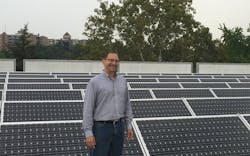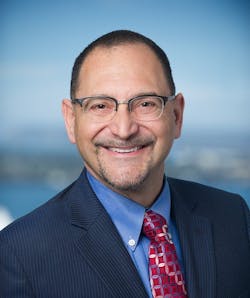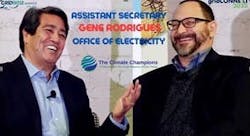Champion of the Smart Grid: Lee Krevat Talks Long Game on Decentralizing Energy
For someone who originally cut his teeth in the Silicon Valley technology sector, Lee Krevat might be one of the happy warriors and true renaissance men of the energy transition era.
As a math and computer science major, Krevat originally focused on software development, architecture and engineering for Tandem and other tech firms. His IT experience eventually inspired him to make a career change and move into the utility industry with Sempra Energy (formed by the merger that united San Diego Gas & Electric and Southern California Gas under one parent company).
Moving to and falling in love with Sempra’s headquarters city of San Diego, a series of wildfires that plagued intensified Krevat’s concern about climate change, which led to his desire to help advance smart grid infrastructure. He was part of the team which guided SDG&E to develop the Borrego Springs microgrid project. While at Sempra, he also played significant roles at Sol Systems, GridX, PI Energy and PXiSE Energy Solutions.
Moving on from Sempra in 2018 he formed the advising firm Krevat Energy Innovations and co-founded Sustain 6, a platform that helps promote employee engagement and action in helping solve the climate crisis. He also played strong leadership roles at two other companies: Connect California, a firm enabling electric customers to lower the cost of distributed energy resource (DER) installations and leverage energy assets they already have to provide sustainable and affordable energy resiliency, and cloud-based data storage startup RestorVault.
Hard to imagine Krevat would have any spare hours, but, somehow, he became energized by the concept of podcasts and started The Climate Champions podcast . Now beyond 150 episodes, he has interviewed energy transition movers and shakers on the federal, regulatory, private enterprise, utility and venture capital fronts.
Krevat graciously carved out time to speak recently with Microgrid Knowledge Managing Editor Rod Walton and EnergyTech Senior Editor Breanna Sandridge about his wide-ranging career and lifelong devotion to helping facilitate technology that can potentially reverse climate change by decarbonizing the energy and industrial sectors. (Microgrid Knowledge and EnergyTech are both part of Endeavor Business Media.)
He is open-minded and acknowledges the ups and downs, headwinds and tailwinds of decentralizing the energy grid. Krevat sees the many paths to net-zero goals as a multipronged approach with some setbacks possible, but the mission always aiming forward.
Rod Walton/Microgrid Knowledge (MGK): Lee, thanks for joining us and letting us pick your brain. Congrats on the 150-plus episodes of The Climate Champions podcast. One of your guests was Jigar Shan, a rock star among the environmental crowd for his role at the DOE’s Loan Programs Office. Billions of dollars are going out toward clean energy projects, and it feels like a true golden age for public support of the energy transition. Do you think that’s true?
Lee Krevat : I think it’s great what we’re doing, but I don’t want to declare victory . . . It’s exciting now, but I don’t think we can ever stop fighting to keep the momentum going because there are those who would have financial reasons to stop that momentum. There are people who want to kill it.
I’m just not ready to celebrate. I believe that as good as things are, there are also some things on the other side such as growing political efforts to stop it. The impact of climate change is happening at a much faster rate than most people anticipated. We are seeing feedback loops that are worse than people expected (referring to weather examples where change in one part of the climate system comes back and amplifies itself to create a greater and more destructive impact). So when I’m asked, I just can’t help but see the balance between what is exciting and excellent . . . and what is very scary.
MGK: Another DOE rock star you’ve interviewed is Gene Rodriques, assistant secretary for the DOE Office of Electricity. We’re super psyched that Gene will be one of our keynote speakers this April at the Microgrid 2024 Conference in Baltimore. Of course, his office must maintain a more holistic approach, which supports all parts of the grid, but what do you think about the federal commitment to microgrids and decentralized, distributed energy projects, in particular?
Krevat: Gene is unique, and he supports and truly understands it. A lot of people in government don’t fully grasp both sides of distributed energy resources; I’m very pro-DER, but I do understand the economic issues around solar.
When you look at microgrids, it’s even more of a serious issue that has to be figured out. Gene gets all sides of the issue and the complexities. A lot of people . . . have a lot of skin in the game, so they’ll take the side that produces the money. But there are a lot of truths that have to all work for society to move into microgrids.
MGK: Such as?
Krevat: I believe in a network of “greedy” grid-attached microgrids — that’s the best thing. What I mean by greedy is that when energy is expensive, they’re going to use their own energy and sell it back to the grid and get that money. And then, when energy on the grid is inexpensive, that’s when they are going to build up. It might cost more to use their own energy, such as the diesel they have to use because it’s cloudy out and you’re not making your own (solar) energy. You may not have the backup energy because you sold at the highest price back to the grid.
Microgrids have to be intelligent and understand how to optimize the cost for the owner/beneficiary of the microgrid. They need to consider if they want to have energy left over if the grid goes down. I can see artificial intelligence making that decision — is this the type of circumstance that would make the grid go down, so maybe I shouldn’t sell even if prices are good.
If microgrids are going to be greedy, if everyone has one, then who pays for the grid that we just talked about that you’re buying energy from and selling into? The grid has to be able to make energy when everyone wants and be able to get it somewhere when everyone sells. It needs to be like a stock market. But we don’t have the technology for the homeowner to be able to make it and sell it at a real price . . . then the questions become “Are you willing to pay the cost to have a seat at the table?” and “How will that be collectively connected — by transaction?”
There has to be some way to get energy to people who aren’t making their own, there has to be energy supplied to everybody, and there has to be wires to get the energy there. So, we need to keep the grid alive and make energy when necessary. Is it a government function or paid through taxes? We need to figure that out.
MGK: Transportation electrification is supposed to be the wave of the future and a potential driver for microgrid deployments. However, we’ve seen some setbacks in the electric vehicle (EV) industry lately, such as Ford’s EV unit losing billions of dollars and Hertz jettisoning one-third of its EV rental fleet. Are these temporary losses or something worse?
Krevat: It’s very concerning. On one hand, for anybody who has driven an EV and charged it, how do you help but love it? I don’t know what the gas prices are anymore; I just come home and plug it in. How does it not succeed? It’s something we have to do. It’s only a matter of when. . . . The cars are getting better, and there’s more variety than ever before.
I’m on the fence because when renting an EV, will you have access to charging in a city you’re not familiar with? I have no charge anxiety (with my home EV charger), but I have anxiety with renting a car. ... Ford can’t deny having some problems in the EV space, and the Ford Lightning (EV truck) is a pretty decent vehicle, so it’s a concern.
It’s all a matter of time because, ultimately, that’s where it’s all going, but we might need more time than we can afford. I understand all the reasons [for the setbacks], but as someone who has driven an EV for a while, I can’t imagine going back, so it’s hard to understand.
MGK: So, we’ve talked about renewables, microgrids and EVs — probably the leading lights of the energy transition. But the motto at EnergyTech, in particular, is “Many Paths to Net Zero.” What do you think about other alternatives, such as waste disposal, carbon capture and the circular economy? Are those sustainable and somehow economical someday? Will they make a big enough difference to aid in true decarbonization?
Krevat: Yes, all arrows in the quiver — that’s fundamentally important. I don’t think we know what the answer is. Microgrids? Excellent, I say all-in on microgrids, but it doesn’t mean no to all-in on everything. Yes to geothermal. Yes to (nuclear) fusion. Yes to small modular (nuclear) reactors. . . . I don’t think we can afford to be picky because we are in a race between the good news and the bad news, and I don’t want to put limits on anything that could be good news.
MGK: What about hydrogen?
Krevat: I do think it’s a yes. Hydrogen is always 10 years away, which saddens me, but I think the potential of hydrogen can be done at a clean and reasonable cost. Holy cow, it’s an incredible (carbon-free) fuel at that point.
MGK: What can bring that 10 years down to two years?
Krevat: It’s unlikely, but a technology breakthrough that we don’t expect right now will push it forward.
MGK: Finally, we keep hearing that the industrial sector, in many segments, is lagging in its progress and commitment to keep pace with those 2050 net zero goals. What do you think will happen if there is a slackening of the pace of decarbonization as first promised by the Paris Agreements? How can it be refocused?
Krevat: When you talk about the industry, the Paris Accord isn’t their goal. Their goal is the bottom line. They have employees, shareholders and investors, and they are going to focus on the money. What’s really helped move it towards any of the Paris goals is that the price is becoming such that they can save money by moving in that direction.
If we don’t get the economics right, then people won’t invest. They want to invest, but if the economics aren’t right, then they can’t jump on board. Utilities aren’t the only industry that doesn’t take risks. For a utility, safety and reliability are everything, and nobody ever got fired for staying with the accepted standards, so that will always be in the way even if the economics look good.










